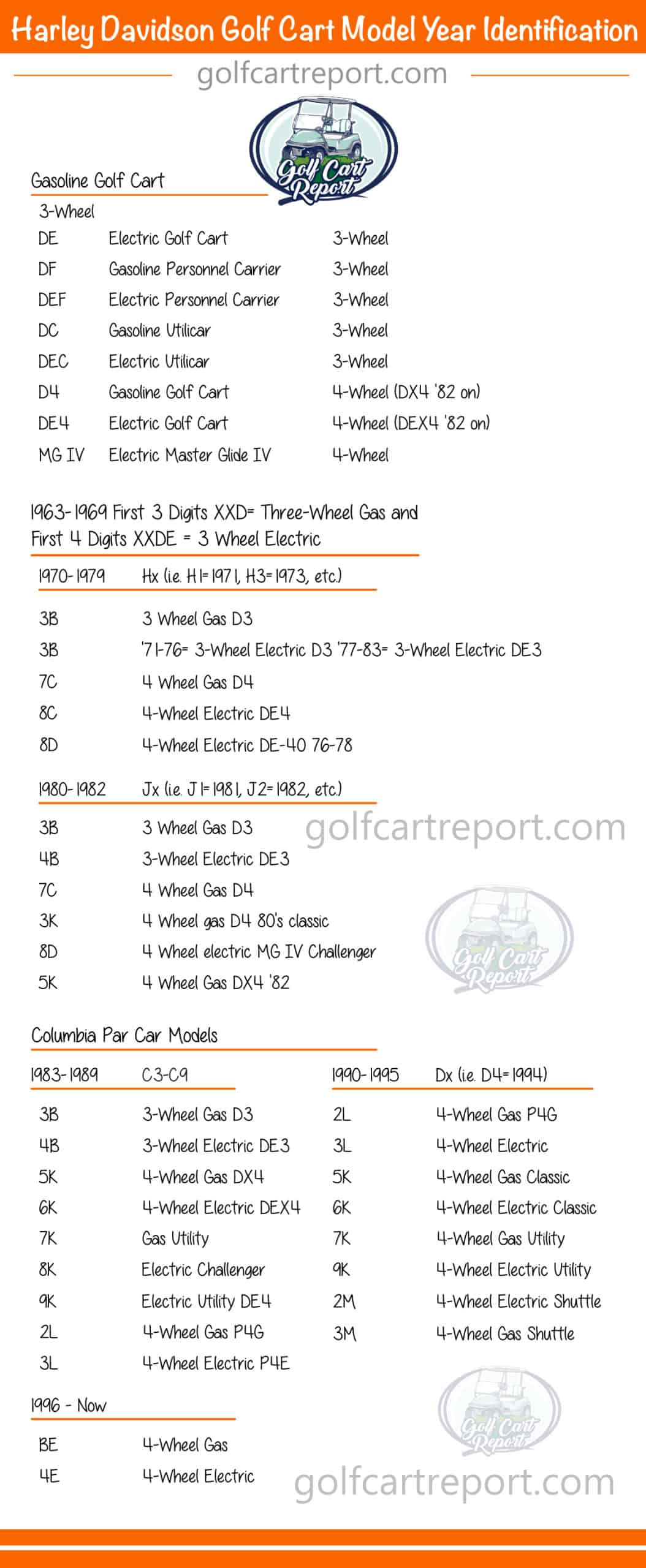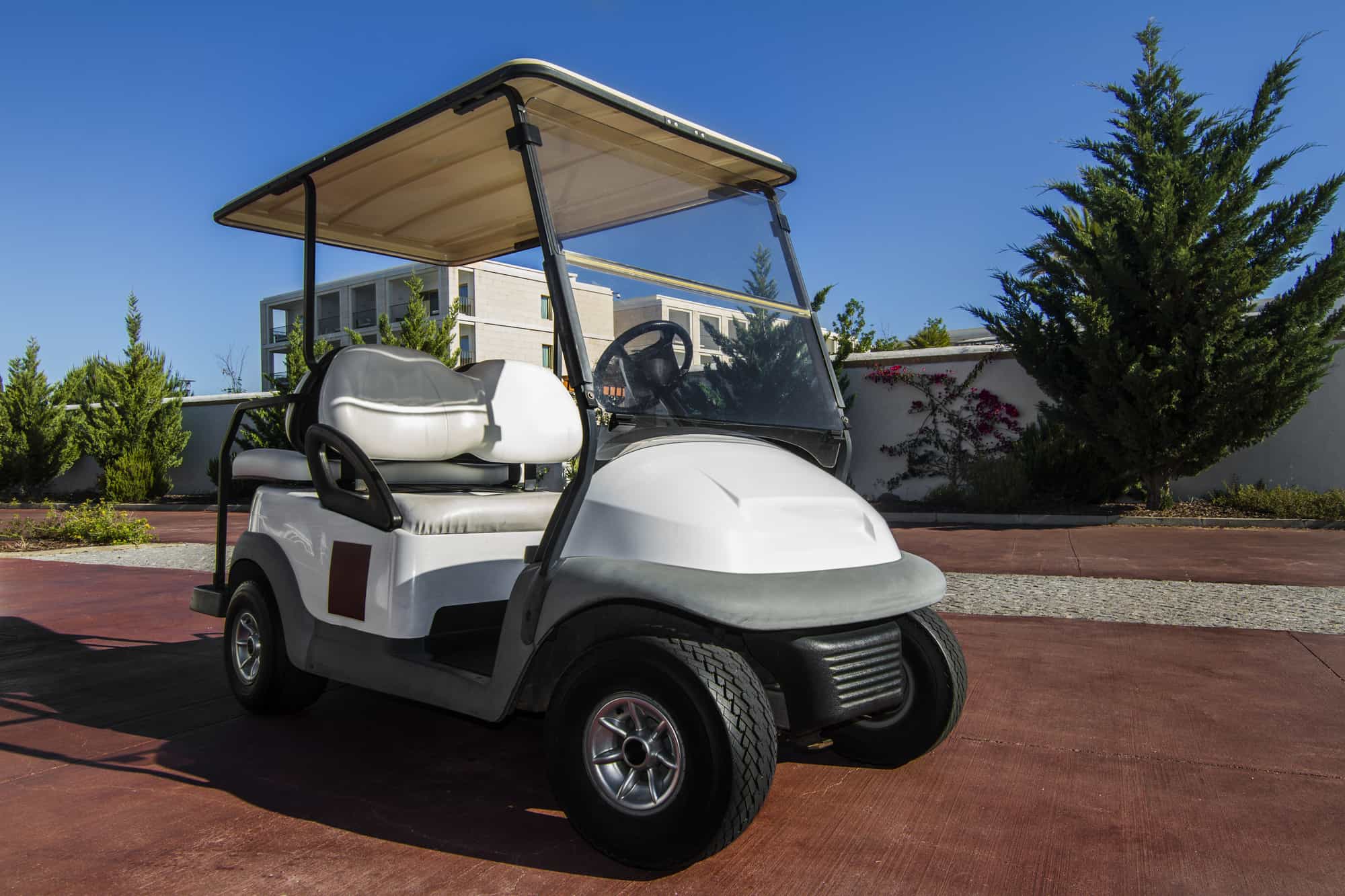The name Harley Davidson is synonymous with motorcycles in a way that no other manufacturer is but this company had a unique foray into golf cart manufacturing.
Although they no longer produce these carts, you may find one on the market or own one already.
And if you do, you might want to know how to gauge its year, as there are few experts who can provide that guidance left.
Thankfully, there are several ways that a cart owner, such as you, can gauge the year of their Harley Davidson golf cart.
Typically, you’re going to be able to examine a few different elements, such as a simple serial number arrangement or the solenoids in your electrical engine.
We’ll include a detailed list of serial number codes here, as well as a detailed examination of solenoid layout to help you out.
A Brief Look at Harley Davidson Cart History
Harley Davidson Golf Cart #GolfCartTuesday #golfbiz pic.twitter.com/3cMuGZfNm7
— Pierre Demers (@PierreDemers) May 9, 2017
Before learning more about gauging your cart year, let’s take a look at Harley Davidson cart history.
This information helps to provide context for your cart and is interesting to know.
In a way, it is typical of what could be called the “golf cart wars” of the 1960s and 1970s.
During this time, fly-by-night regional manufacturers produced many different models and created a rather diverse marketplace.
This market contrasts heavily with today’s more corporate environment, where only a handful of major golf cart manufacturers are left.
By contrast, back in 1963, Harley Davidson was the world’s biggest motorcycle company and curious about branching out into other areas.
So – partially pushed by William “Willie G” Davidson – the company started producing golf carts that year.
They produced mostly three-wheel models but expanded to four-wheel ones later.
You really do see it all at the Donnie Smith Bike & Car Show! Check out this 1967 Harley-Davidson golf cart entered into the open class! ⛳🏍😜
.
.
.
.#donniesmithshow #harleydavidsonaddicts #harleydavidsongolfcart #golfcart #golfcar #golfcarts #kustom… https://t.co/J1pSRRrhYD pic.twitter.com/lX7Rt3gweZ— Donnie-SmithBikeShow (@DSBikeShowMN) September 24, 2018
Their earliest carts used a 245 cc dual-cycle single-cylinder air-cooled engine that mixed oil with gas in a fairly standard way for small vehicles.
The chassis and engine remained, more or less, the same for just about the entirety of Harley’s cart production years.
By 1969, they were sold to American Machine and Foundry Company, who changed the name of the company to AMF in 1971.
Between 1969 and 1971, they kept the Harley logo but added an AMF logo in 1972.
Ten years later, Columbia Par Car purchased AMF and changed up the engine’s pistons very slightly.
The body design switched permanently to four-wheels, which could be seen as the end of the Harley Davidson cart production.
This information serves not just as background information but also helps provide you with some tips for dating your cart.
For example, if you find an AMF logo on the body, you can age it between 1972 to 1981.
And if the piston sizes are larger, you can gauge its age to be around the time that they were purchased by Columbia Par Car.
Harley Davidson Gas Golf Cart Repair Manual 1963 – 1980 https://t.co/OCBmhWmdJT pic.twitter.com/5DR057NU8Q
— PlayGolf™ 🔵 (@golf_bargains) August 20, 2018
Thankfully, there are more accurate ways to get a very specific understanding of your cart’s year of production.
Using the Serial Plate
The easiest way to find the age of your Harley Davidson golf cart is to use the serial plate.
Typically, this plate is located somewhere the rear wheel of the cart.
For example, on models with a liftable rear end – you will see a hinge near the back that allows you to lift the back and work on the engine and chassis – you are likely to find the plate on a frame rail on either left or right side of your rear wheels.
However, you may have an electric cart – rarer but still available – in which case you won’t have a hinge or a liftable rear.
Instead, you’ll find the serial plate underneath of the driver’s seat.
You’ll usually see it more towards the passenger side of the cart, so pay attention to this location.
Usually, you’ll find the serial plate hear on DE40 and MGIV electric Harley Davidson carts.
Once you find the serial number, you’re going to see one of two different formats or layouts.
The first of these were used during the 1960s and feature eight different numbers.
The first two numbers indicate the year of the cart.
The next digit – a letter – indicates its model.
And the last five identify the specific production model i.e. when the cart was built on the production line.
So let’s say you find a cart with the serial number 63D38422.
This number indicates a golf cart built in 1963, based on the first two digits.
The D represents a gas cart model, which was the the most popular type being produced by Harley Davidson at that time.
And the last five digits would indicate that it was cart number 38,422 produced in that specific year.
In this way, you get as accurate of an understanding as possible.
The numbers of the cart got more involved later in the 1970s and 1980s.
They added one more digit and changed the arrangement and the meaning of each digit in ways that may be confusing.
The first two digits represented the model before a break indicated the start of the model production number.
This five-digit number has a break at the end after which is a letter and a number indicating the year of production.
Confused?
Let’s take a look at a typical serial number of this type to give you an idea of how to read it – 8C 15384 H8.
The toughest element of this number are the first two digits.
What exactly does 8C mean?
Well, it represents a four-wheel electric DE4 cart model.
Why?
That’s a secret Harley Davidson is likely to take to the grave.
The next five numbers are easy enough to understand – they are the production number.
So this cart was number 15,384 of that production year.
Now, the next two digits are also confusing: how does H8 represent a production year?
Simple: the H stands for the 1970s and the eight stands for the last number in the year.
So H8 means 1978, H3 would mean 1973, etc.
The 1980s used a J in place of the H, which is the biggest way to gauge this factor.
And while Harley themselves no longer produced carts after 1981, there are other models produced by Columbia Par Car that use a similar chassis.
The following chart should help you identify your cart more easily:

Gasoline Golf Cart
3-Wheel
DE Electric Golf Cart 3-Wheel
DF Gasoline Personnel Carrier 3-Wheel
DEF Electric Personnel Carrier
3-Wheel
DC
Gasoline Utilicar 3-Wheel
DEC Electric Utilicar 3-Wheel
D4 Gasoline Golf Cart 4-Wheel (DX4 ’82 on)
DE4 Electric Golf Cart 4-Wheel (DEX4 ’82 on)
MG IV Electric Master Glide IV 4-Wheel
1963-1969 First 3 Digits XXD= Three-Wheel Gas and First 4 Digits XXDE = 3 Wheel Electric
1970-1979 Hx (i.e. H1=1971, H3=1973, etc.)
3B 3 Wheel Gas D3
4B ’71-76= 3-Wheel Electric D3 ’77-83= 3-Wheel Electric DE3
7C 4 Wheel Gas D4
8C 4-Wheel Electric DE4
8D 4-Wheel Electric DE-40 76-78
1980-1982 Jx (i.e. J1=1981, J2=1982, etc.)
3B 3 Wheel Gas D3
4B 3-Wheel Electric DE3
7C 4 Wheel Gas D4
3K 4 Wheel gas D4 80’s classic
8D 4 Wheel electric MG IV Challenger
5K 4 Wheel Gas DX4 ’82
Columbia Par Car Models
1983-1989 C3-C9
3B 3-Wheel Gas D3
4B 3-Wheel Electric DE3
5K 4-Wheel Gas DX4
6K 4-Wheel Electric DEX4
7K Gas Utility
8K Electric Challenger
9K Electric Utility DE4
2L 4-Wheel Gas P4G
3L 4-Wheel Electric P4E
1990-1995 Dx (i.e. D4=1994)
2L 4-Wheel Gas P4G
3L 4-Wheel Electric
5K 4-Wheel Gas Classic
6K 4-Wheel Electric Classic
7K 4-Wheel Gas Utility
9K 4-Wheel Electric Utility
2M 4-Wheel Electric Shuttle
3M 4-Wheel Gas Shuttle
1996-Now
BE 4-Wheel Gas
4E 4-Wheel Electric
What if my serial plate is worn?
What happens if your serial plate is too worn down to read and you can’t get a feel for the age of your Harley Davidson golf cart?
Well, you can open up the engine and take a look at the solenoid arrangement.
The solenoid is only in electrical cars and serves as the powering element for the engine.
Thankfully, though, its arrangement will be rather easy to read if you know what you are looking for inside your engine.
If you don’t, you’re likely to struggle to identify and age your cart properly.
Therefore, we’re going to break down the solenoid layouts that you’re going to find in typical Harley Davidson golf carts.
Our research will take us from 1963 all the way up to 1982.
Though it may not give you the precise year that your cart was manufactured, it will almost always narrow it down to no more than two or three specific years.
This should help you figure out your cart more accurately.
Model DE – 1963-1966
The first three years of Harley Davidson golf cart manufacture included perhaps the simplest solenoid layout of any of the carts they produced.
There will be six 12-volt connectors in your engine.
And they’ll be arranged in a very simple fashion – in a two-by-three grid.
From this point on, though, the arrangements are going to become more complex, so be prepared to do a little extra work.
And you’re also going to find that the electrical output of these solenoid engines are going to decrease over the next few years.
That decrease occurred because Harley – usually a gasoline-powered-vehicle manufacturer – started to get a better handle on electrical carts.
By the end of their time producing carts, they were among the finest and most respected manufacturer on the market.
Model DEC – 1966-1968
At this point in production, Harley Davidson was adding a few new elements to their carts that required more electricity, such as horns.
As a result, there are two more 12-volt connectors in this arrangement.
You’ll see the same two-by-three grid that was featured in the previous model but will note two more in a vertical arrangement next to this grid.
After this point, the two-by-three grid is abandoned.
Later models will feature more complex or unpredictable layouts.
Some will have two rows – others may have only one.
And others may have staggered and strange layouts that are hard to describe.
As a result, it is important to read through each of these listings carefully as you inspect your engine.
Doing so will make it easier for you to find the specific model for your carting needs.
Model DE – 1967-1971 and Model DEC – 1969-1971
The following layout described here is common in both the DE and the DEC produced by Harley Davidson.
These models indicate different types of electrical models – three- and four-wheel types – but their solenoid layout is the same in both of these models, making it easier to age both of them within at least a 2-4 year span of time in the late 60s and early 70s.
You’ll have two row of connectors in this engine.
The top row will feature two six-volts, the first available in this type of cart.
The bottom row will feature three connectors, including two 12-volts on the side of a single six-volt.
Add all those volts, and you have 42 volts – a decrease from 72-volts and 96-volts from the last two models.
This decrease is due to the fact that the engine was more efficient later in production.
Models DE and DE4 – 1972-1975 and Model DE-3 –1977-1982
The vast range of years available here – from 1972-1982 – may make this solenoid arrangement one of the least effective in gauging your cart’s age.
However, if you know the model type of your cart – such as whether it is a three- or four-wheel – you can age it much more easily.
Thankfully, this layout is also one of the simpler ones and shouldn’t be too hard for you to successfully understand.
It starts out with three 6-volt connectors in a row.
Next, you’ll have two 12-volt connectors for a single row.
Again, we’re down to about 42-volts in this engine.
Though this may not seem to have much power, it should be more than enough for cart owners.
Better design helped to make the carts move more smoothly and increased electrical efficiency also added hours of life to the battery.
Model DE-40 – 1976-1978
This particular cart model was produced for only a handful of years but was one of the most popular choices for Harley Davidson cart buyers.
It’s simple design made it easy to understand and its surprisingly powerful engine used minimal electricity to produce a solid and long-lasting cart option.
You should be able to identify it solenoid quite easily, as it has just three.
There should be only three connectors in your solenoid – three 12-volts arranged in a simple fashion.
The first two should be on the top row of your engine and the third just below the first in a second row.
With just 36 volts, it uses the least amount of electricity of any Harley Davidson golf cart.
As a result, it is a good choice for those who want to keep their cart use as efficient as possible.
Model MGIV – 1979-1982
Lastly, the solenoid for this engine is somewhat unique – it features three staggered rows of five connectors, both 6- and 12-volt.
The first row of these connectors consists of a 12-volt connector followed by two 6-volt.
This arrangement is pretty simple to understand – most cart owners should be able to spot it quite easily without running into any issue.
However, in a row that’s half between the first and the third, there is another 6-volt connector.
And just beneath the second 6-volt on the first row, is the last connector – a 12-volt.
The reason for this complex arrangement has to due with the wiring of these models and is unique among Harley Davidson carts.
Unfortunately, we were unable to find any information regarding Columbia Par Car solenoid layout.
Cart Size Can Also Help
What happens if you cannot read the solenoid or if you have a gasoline engine instead?
You can use the size of the cart to get a feel for its age.
For example, models between 1963-1963 should have a wheel base of 59.5 inches and a length of 92 inches.
They should also weight about 660 pounds, though this weight may vary a couple of pounds.
To help you out here, we have created a useful chart that will showcase the wheel base, the length, and weight of all the models that we could find for Harley Davidson.
All length measurements are in inches and weight is in pounds
DC 1966-68 – 60.5 base, 93.5 length, 755 weight
DC 1969-72 – 70.5 base, 98.5 length, 760 weight
D 1963-66 – 59.5 base, 92.5 clearance, 624 weight
D 1967-76 – 60.5 base, 91.0 length, 694 weight
D 1977 and Later – 60.5 base, 91.0 length, 693 weight
D4 1972-76 – 67.0 base, 102.0 length, 821 weight




Leave a Reply